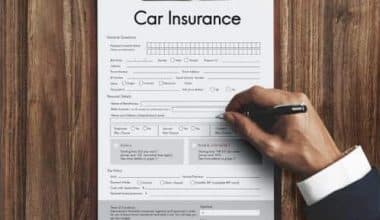The amount you regularly pay your insurance company in exchange for motor coverage is known as your premium for car insurance. Business Yield will look at a few of the variables that affect your particular premium in this post. To help you identify the best fit for your needs in terms of coverage and price, we have also conducted research on the top car insurance providers.
A car insurance premium is the cost of coverage for your car. You will be given an estimate of the amount you will have to pay when you shop for auto insurance and request a quote. Depending on your option, your insurance carrier may ask you to pay for coverage once a month, every six months, or once a year.
Furthermore, your auto insurance premiums will often increase in proportion to the level of risk your insurer deems you to be. For this reason, the cost of insurance will be higher for an adolescent driver with limited driving experience or an individual with a history of accidents compared to a middle-aged driver with no past fines or claims.
You can lawfully drive, and your policy will remain active (i.e., your costs will be paid in the case of an accident or property loss) as long as you pay your auto insurance premiums on time. Your license may be suspended until you reinstate your coverage if your insurer cancels your insurance due to nonpayment.
Several risk factors are taken into account by insurance companies when determining your auto insurance rates. The majority of states let insurance companies determine your rates based on information about you and your vehicle, as well as your driving habits.
Although every insurance provider sets rates independently, most of them base your price on a few common factors:
#1. The quantity of coverage you purchase:
You’ll be better off in the case of an accident if you buy additional coverage for your policy and add-ons like gap coverage, roadside assistance, and rental car insurance, but your insurance premiums will go higher.
#2. Your location:
The cost of auto insurance varies by state, city, and even ZIP code. more rates of uninsured drivers, a greater number of drivers, and more medical expenses are all associated with higher insurance premiums.
#3. Your record when driving:
Compared to their peers, drivers with a history of collisions, citations, or inexperience behind the wheel pay more.
#4. Your past policy history:
If you have never had insurance before or if your coverage has already lapsed, your premiums may be higher than average.
#5. Your age:
Younger drivers, particularly teenagers, pay significantly higher premiums for coverage from insurers.
#6. Your credit score:
In the majority of states, insurance rates are higher for those with low credit scores and lower for those with excellent credit histories.
#7. The kind of car you drive:
Insurance for new, premium cars with lots of technology features is more expensive than for simpler versions.
#8. How often do you drive?
Because drivers who drive less are less likely to be in accidents, insurance companies offer lower premiums to those drivers.
#9. The number of drivers on your policy:
Your premiums will go up if you add more drivers, particularly if they are deemed high-risk drivers. That being said, most insurance providers also give discounts for insuring multiple vehicles.
View your state’s average below.
| State | Average car insurance premiums for good drivers |
| Alabama | $1,546 |
| Alaska | $1,325 |
| Arizona | $1,731 |
| Arkansas | $1,803 |
| California | $2,466 |
| Colorado | $2,034 |
| Connecticut | $1,463 |
| Delaware | $1,767 |
| Florida | $3,158 |
| Georgia | $1,686 |
| Hawaii | $1,157 |
| Idaho | $1,171 |
| Illinois | $1,693 |
| Indiana | $1,296 |
| Iowa | $1,243 |
| Kansas | $1,940 |
| Kentucky | $2,233 |
| Louisiana | $3,544 |
| Maine | $1,022 |
| Maryland | $1,790 |
| Massachusetts | $1,836 |
| Michigan | $2,470 |
| Minnesota | $1,686 |
| Missouri | $1,834 |
| Mississippi | $1,655 |
| Montana | $1,501 |
| Nebraska | $1,718 |
| Nevada | $2,176 |
| New Hampshire | $1,066 |
| New Jersey | $2,332 |
| New Mexico | $1,692 |
| New York | $1,780 |
| North Carolina | $1,275 |
| North Dakota | $1,372 |
| Ohio | $1,171 |
| Oklahoma | $1,840 |
| Oregon | $1,543 |
| Pennsylvania | $1,790 |
| Rhode Island | $1,934 |
| South Carolina | $2,025 |
| South Dakota | $1,889 |
| Tennessee | $1,323 |
| Texas | $1,574 |
| Utah | $1,514 |
| Vermont | $1,174 |
| Virginia | $1,220 |
| Washington | $1,427 |
| West Virginia | $1,582 |
| Wisconsin | $1,299 |
| Wyoming | $1,452 |
Here are some steps you can take to reduce your car insurance premium.
#1. Shop around.
Comparing quotes from several insurers for auto insurance is frequently the best approach to saving money. Comparing rates is a simple way to determine whether you’re overpaying because they can differ by hundreds of dollars for the same policy.
#2. Request discounts.
You might qualify for discounts on auto insurance, such as those offered to cautious drivers or deserving students.
#3. Take a defensive driving course.
If you have any points from traffic tickets on your driving record, taking a state-approved driving course could help you get cheaper auto insurance. After finishing a driving safety course, some insurance companies provide their policyholders with discounts. Additionally, in certain areas, drivers who complete a safety course at a specific age—such as age 55—are required to receive a discount.
#4. Increase your deductible.
A larger deductible for collisions and comprehensive insurance can help you save money. Just make sure you have the money to pay for larger out-of-pocket expenses should you need to make a claim on your auto insurance.
Based on a Forbes Advisor review of the top low-cost auto insurance providers, USAA auto insurance offers the lowest rates overall. However, only veterans and their families, as well as active military personnel, are eligible for USAA auto insurance.
Furthermore, Geico, State Farm, Erie, and Travelers offer competitive rates based on national averages if you are not eligible for USAA. Obtaining estimates from multiple insurance providers is a smart move as well, as the most affordable ones may differ depending on your state, driving history, and other variables.
| Company | Average annual car insurance premiums |
| USAA | $1,141 |
| Geico | $1,182 |
| State Farm | $1,402 |
| Erie | $1,419 |
| Travelers | $1,435 |
| Auto-Owners | $1,532 |
| Nationwide | $1,540 |
| Progressive | $1,892 |
| Allstate | $2,022 |
| Farmers | $2,124 |
The majority of American Express cards allow you to add primary insurance for a fair flat fee per rental, even if they don’t come with supplementary coverage for vehicles. It is not necessary to file with any other insurance before filing with American Express if you have primary coverage. For some benefits, enrollment is necessary.
For premium cards like the Delta SkyMiles® Reserve American Express Card and the Hilton Honors American Express Aspire Card, the following is what rental car insurance from American Express typically covers:
- Theft of an insured vehicle rental.
- The car has sustained physical damage.
- Accidental limb loss or death.
- Accident-related harm.
- Personal property coverage when renting a car.
- Charges for loss of use that the agency bears.
- Valuation charges.
- Reasonable costs for towing.
How to save money on car insurance?
There are a few tactics you can employ in an effort to reduce your auto insurance premium:
#1. Remove excess coverage.
Your premium will go down if you do so. Reducing these kinds of coverage is often advised when your yearly premium exceeds 10% of the total worth of your car. Remember that in order to drive legally, you must meet the minimum insurance requirements set forth by your state, so you shouldn’t lower your needed policies or your liability insurance for bodily injury or property damage.
#2. Compare rates:
Compare prices for auto insurance from several companies by shopping around. It’s possible that switching insurance providers will result in big savings.
#3. Take a driver safety course.
After completing a state-approved driving safety program, many insurance companies offer discounts. These seminars last six or eight hours on average, and if you finish one, several states require insurers to give you a discount.
#4. Choose usage-based insurance.
Usage-based discount schemes are provided by numerous insurers. Usually, these are operated by an app that keeps track of your average speed, stopping distance, and driving times.
#5. Bundle your policies:
If you already have renters’ or homeowners’ insurance, you can typically receive discounts on your auto insurance by getting both policies from the same provider.
#6. Make a payment in advance.
Most insurance companies offer you a discount if you pay your premiums in full upfront.
Depending on your insurance company, there are a few different ways you can pay for your premium, but most accept the following methods:
- Through a mail-order check
- Online via the website of the insurer
- Online, using the mobile app for the insurance
- Automatically, through the use of autopay
When making an online payment, you can choose to link your bank account for a cash transfer or input the details for your credit or debit card. If the firm that insures your car is a financial services provider (such as USAA or State Farm), you can use the same login credentials to access both your insurance and checking account.
Although several also provide month-to-month payment arrangements, the majority of insurers demand that you pay your premium every six or twelve months. You may set up automatic payments with most insurers so that money is deducted from your bank account on a monthly basis and you never forget to make a payment. If you set up autopay or pay your entire yearly payment upfront, you may be eligible for a premium discount.
Regular payments are expected, and many firms provide three- and six-month premium payment choices. Payments can be made in increments of one month or annually.
When making an online payment, you can choose to link your bank account for a cash transfer or input the details for your credit or debit card. If the firm that insures your car is a financial services provider (such as USAA or State Farm), you can use the same login credentials to access both your insurance and checking account.
Is it better to have a $500 deductible or $1000?
Although many insurance providers offer comparable rates for $500 and $1,000 deductibles, generally speaking, having a bigger deductible decreases your insurance premiums. Some businesses might just charge a few dollars more a month, so in certain cases, going with a $500 deductible is the wiser choice.
Why is Allstate so expensive?
Allstate’s high price is a result of several reasons, such as the way it compensates its agents and the growing expenses of insurance firms. Its higher-than-average rates also take into account damage claims and compensation.
A premium is the amount of money you must pay in addition to the standard price for anything. Premium goods are typically more expensive and of a higher caliber than average.
The monthly premium cost is the amount you pay for your insurance every month. You often have to pay a deductible, copayments, and coinsurance in addition to your premium for your medical care.
A car insurance premium is not the same as a car insurance quote. This is the primary distinction:
- Car insurance quote: This is the approximate price of an insurance policy for a vehicle.
- Car insurance premium: This is the actual amount you pay the auto insurance company for coverage.
It’s possible that your auto insurance rate will be higher than what you were first quoted online. The information you supply to an insurance company determines your quote, but there are a number of reasons why the actual rate may differ.
Here’s the key difference between a car insurance premium and a deductible
- Car insurance premium: This is the amount you pay for a car insurance policy.
- Car insurance deductible: This is the amount deducted from an insurance check if you file a claim.
Depending on your insurance provider, you can normally choose to pay your premium in monthly installments, twice a year, or all at once. Note that the majority of auto insurance providers provide a pay-in-full discount.
Generally, you can use a credit card, debit card, bank account, or savings account to pay for your auto insurance payment. The following payment choices may be provided by your insurer:
- Online
- Via phone
- Via mail
Note that you can typically receive an electronic funds transfer (EFT) discount of 3% to 6% if you pay your auto insurance premium in installments and arrange for an automated withdrawal.
Your auto insurance coverage will eventually be canceled for non-payment if your premiums are not paid.
Depending on your state, your auto insurer may need to provide you with notice via email or letter before canceling your coverage. Depending on your state, you typically have 10 to 20 days to make a late payment.
You have an insurance lapse if your policy is canceled, and this might increase the cost of your next insurance purchase. If you are detected driving without auto insurance, you may have severe financial and legal repercussions.
Therefore, you should get in touch with your insurer as soon as you are unable to pay for your auto insurance. They might arrange for a payment plan or prolong the grace period.
When your coverage renews, your auto insurance rate may increase. You may notice a rise for the following typical reasons:
- An automobile collision was your fault.
- A moving traffic violation was issued to you.
- Your auto insurance claim was filed.
- You extended your policy to cover another car.
- You updated your coverage to include a new driver.
- In your location, there has been a rise in claims (such as auto theft or weather-related claims).
- You changed your ZIP code.
- There was a gap in your coverage.
- You can no longer take advantage of some deals.
How can I avoid paying my car insurance deductible?
If you are unable to pay your deductible, you have the following options:
- Decide not to submit a claim until you have received the funds.
- Verify your coverage; you might be exempt from paying in full.
- Make an agreement with your mechanic.
- Obtain a loan.
What is a good car insurance deductible?
Although many insurance providers offer comparable rates for $500 and $1,000 deductibles, generally speaking, having a bigger deductible decreases your insurance premiums. In some cases, a $500 deductible is the best choice because some businesses might only charge a few dollars more per month than the competition.
Can I Insure a Car Not in My Name? All You Need To Know
WHAT IS A PREMIUM IN INSURANCE? All You Need To Know
Insurance Premium vs. Deductible: What Are the Key Differences?






